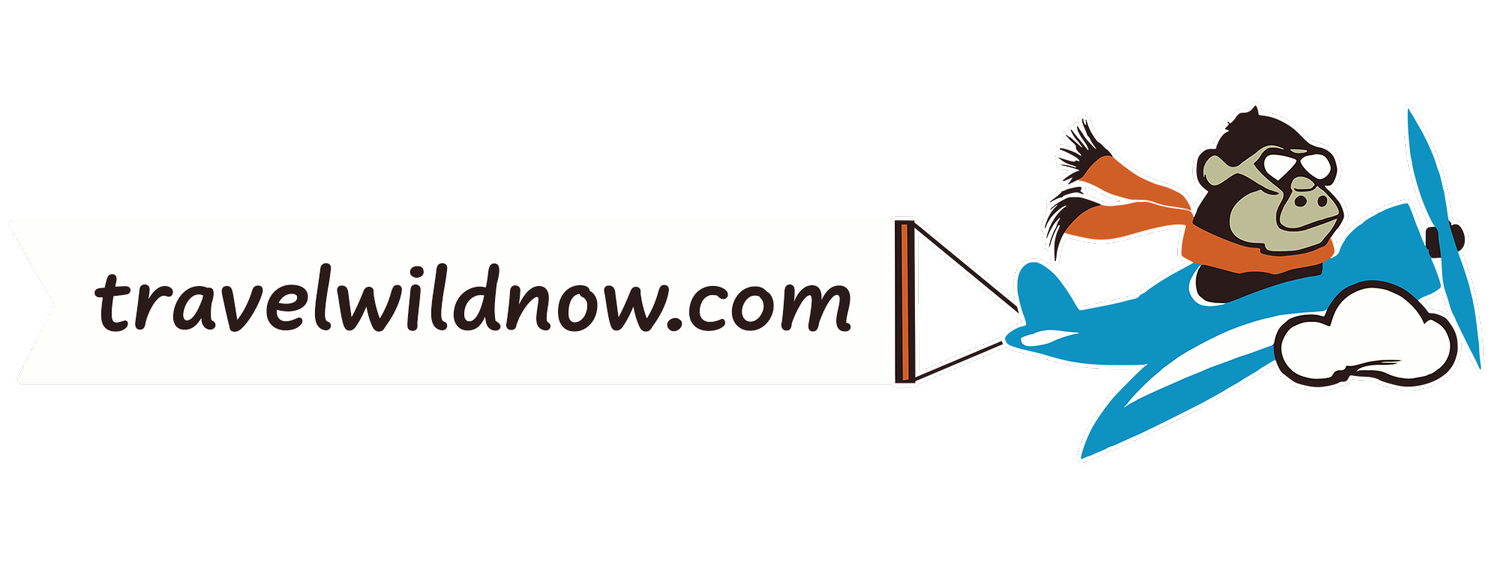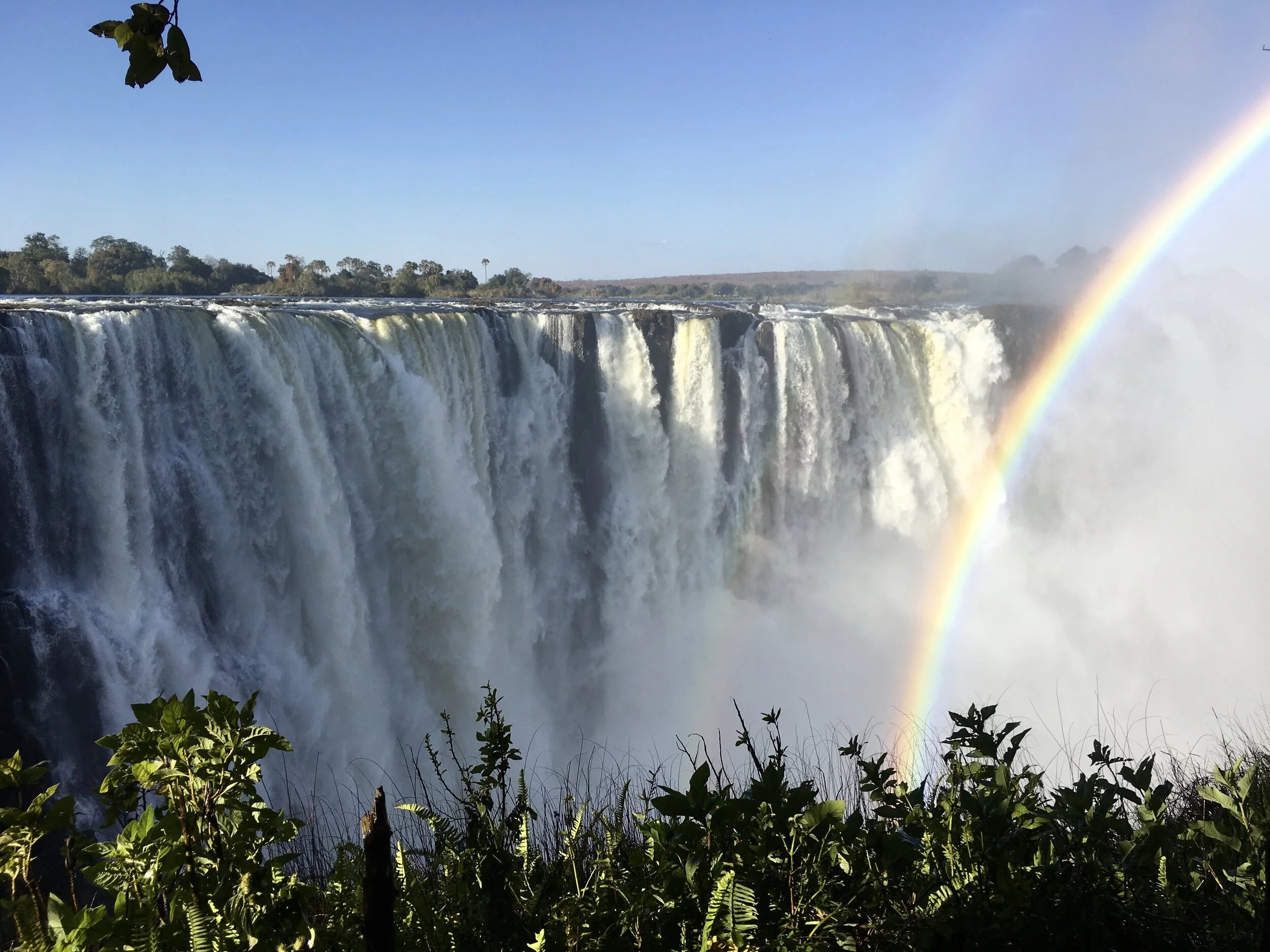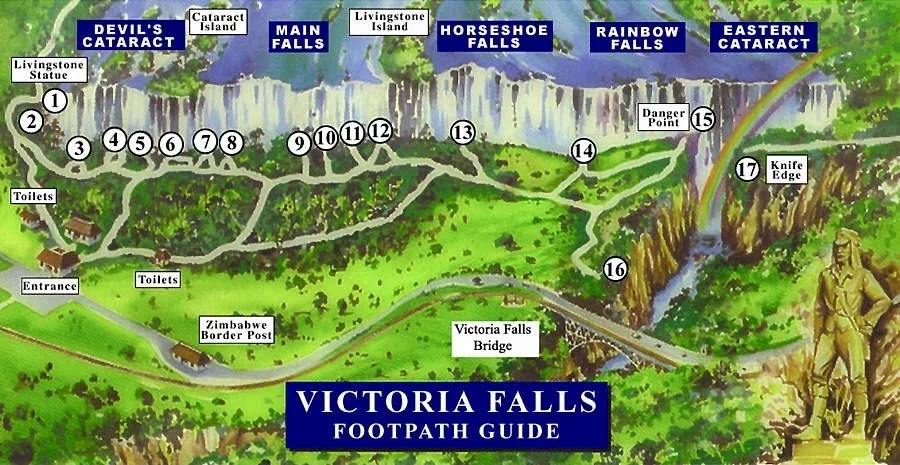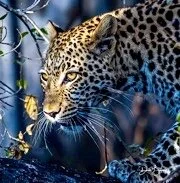
BOTSWANA 8 Days
This itinerary includes Victoria Falls in Zimbabwe, Chobe National Park, and Moremi Game Reserve in Botswana.
Wild Botswana is a landlocked country defined by its diverse landscape of desert, grasslands, and waterways, offering an unforgettable safari experience in some of Africa’s most pristine and remote game areas.
In the heart of the Kalahari Basin, in the northwest of Botswana, lies a stunning natural wonder: the Okavango Delta (Moremi Game Reserve). The Delta is one of Africa's last great natural sanctuaries, a pristine wilderness home to vast concentrations of wildlife.
Chobe National Park, Botswana's third-largest national park, is named after the Chobe River, which flows along its boundary. The park is famed for its elephants, diverse habitats, wide variety of animals and birds, and its magnificent river, which allows for exceptional game viewing by boat.
Botswana’s economy—driven by mining, cattle, and tourism—has become one of Africa’s fastest-growing. Botswana is similar in size to France.
<Kindly note: The Photo Gallery can be found at the bottom of this page>
Before you go:
Travelwildnow.com strongly advises using a licensed tour operator for your safari. They provide personalized plans and stay with you the whole trip.
You can find reputable companies through popular travel guides like Lonely Planet & Bradt travel guides.
-
Micato Safaris: Renowned for their personalized service and deep knowledge of African wildlife, Micato Safaris offers both luxury and classic safari experiences in East Africa.
Wilderness Safaris: Specializing in eco-friendly and sustainable safari experiences, Wilderness Safaris operates in several African countries and focuses on wildlife conservation and community development.
Expert Africa: Known for their authentic safari experiences and intimate camps, Expert Africa offers guided safaris emphasizing wildlife encounters and cultural immersion.
AndBeyond: Offering luxury safaris in several African countries, AndBeyond is recognized for its conservation efforts and exclusive safari lodges located in prime wildlife areas.
Asilia Africa: A leader in responsible tourism, Asilia Africa operates safari camps and lodges in East Africa, providing authentic safari experiences while supporting local communities and wildlife conservation.
Singita: With luxurious lodges and exclusive safari experiences, Singita operates in South Africa, Zimbabwe, and Tanzania, focusing on wildlife conservation and sustainable tourism practices.
Great Plains Conservation: Known for their conservation-focused safaris, Great Plains Conservation offers luxury safari experiences in Botswana, Kenya, and Zimbabwe, with a commitment to wildlife protection and community development.
Ker & Downey Africa: Specializing in customized luxury safaris, Ker & Downey Africa offers personalized itineraries across various African destinations, ensuring high-quality service and unique wildlife encounters.
These safari tour operators are highly respected within the industry for their commitment to conservation, sustainability, and providing exceptional safari experiences to their clients. It's always advisable to research and read reviews before choosing a specific operator to ensure they align with your preferences and expectations.
-
When you plan a large-scale trip like a safari, it’s generally part of a tour or vacation package that requires prepayments and deposits. This is why it’s important to consider trip cancellation insurance.
Trip cancellation is the most common travel insurance claim, followed by trip delay and emergency medical expenses due to sickness.
Visiting Botswana - USA and Canadian citizens do NOT require a tourist Visa.
Visiting Zimbabwe - USA and Canadians require a tourist Visa. This can be done online or upon arrival.
As a general rule, passports must be valid for six (6) months beyond the date of travel.
The US dollar is accepted in both Botswana and Zimbabwe. It is recommended to bring US dollars on your trip. ⚠️ Note: ATM’s are not reliable in Zimbabwe.
Before departing check for vaccine and malaria recommendations.
Types of travel adaptors used in Botswana and Zimbabwe: Type D and Type G.
Always keep your camera in a dust-free bag. Driving on unpaved roads brings in dust that can harm your camera.
What does a typical safari day look like?
05.30 am: wake up call by a soft knock and animal sounds.
06.30 am: after fresh coffee or hot tea and a morning snack, start the morning safari activity, (this is typically a game drive or boat trip).
09.30 am: extensive breakfast.
10.00 am - 2.30 pm: time to relax and have lunch.
02.30 pm: second game activity (again: either a drive, mokoro trip, motorized boat trip).
07.00 pm: back in the lodge for dinner, leisure time.
08:30 pm: you may have a option of a evening game drive.
10.00 pm: bedtime.
-
Answer: Animal attacks are definitely on people’s mind when travelling to safari areas for the first time or at anytime.
On safari you will, most likely, come into very close proximity to potentially very powerful and dangerous wild creatures.
Serious injury caused by large animals when out on safari is relatively RARE, but it does happen. The chances of being involved in such an incident are around 1 in 80,000, which is very low.
The most dangerous large animals are elephants and hippos.
The highest levels of risk are usually encountered when out on a walking safari.
-
In general, Botswana & other African countries prohibit drones in national parks.
Each country has rules and regulations regarding drone usage in game reserves and parks. You need to request permission from the Civil Aviation Authority Of Botswana (CAAB) in the form of writing, at least one week prior to your departure.
Please note that some international airlines have rules and regulations regarding LiPo batteries used in drones, so check with them prior to your departure.
-
Some essential considerations:
#1. You’ll need a passport with at least six (6) months’ validity from your departure date, as well as two open pages for your visas.
#2. You may need shots. Most health professionals recommend immunizations for typhoid, hepatitis, and antimalarial medication.
#3. Buy some Quick-dry safari shirts and pants, and a wide brimmed hat to protect yourself from the sun and dust.
#4. Other considerations include binoculars, travel insurance and international phone plans.
DAY 1
Arrive at Victoria Falls airport, Zimbabwe and transfer to your hotel.
A tour guide will meet you at the arrival terminal and assist with the next steps. Tour operators handle all your accommodation needs.
Most hotels in Victoria Falls are within walking distance of the majestic Falls. The Victoria Falls Hotel and Ilala Lodge stand as the closest options for accommodation. <Other hotel options in the area>
If you have time, walk from your hotel to Victoria Falls for a quick view. It is a 10-minute walk from town. You will find an easily accessible trail that runs along the Falls easy and fun, no guide needed.
Overnight: Victoria Falls.
-
The 👀 View Points on the trail:
Devil's Cataract & Livingstone's Statue – Dr. David Livingstone is reputed to be the first European to see the Victoria Falls.
2. The “Chain Walk” – this leads down into the gorge where one gets an excellent view of Devils Cataract and Cataract Island.
3. to 7. Devil's Cataract & Main Falls – you will find many types of bird life as well as flora and fauna.
6. Viewpoint 6 – best spot for views of Devil's Cataract.
7. Viewpoint 7 – provides the best views of the Main falls.
8. Main Falls – when the river is in flood there is very little to see but torrents of spray.
9. to 12. – Main Falls/Livingstone Island/Horseshoe Falls.
11. Viewpoint 11 – provides wet views of Livingstone Island and Rainbow Falls.
14. Rainbow Falls – here is the highest point of the Falls.
15. Danger Point — this part of the trail leads along the cliff edge.
16. Boiling Pot – here one can look down into the turbulent waters.
Bridge Viewpoint – here you can view the Victoria Falls Bridge, linking Zimbabwe and Zambia.
DAY 2
Following breakfast, walk the trail at Victoria Falls with its 16 viewpoints.
Victoria Falls is located on the Zambezi River, and is 1,708 meters wide and 108 meters high.
The appearance of the Falls changes throughout the day due to the sunlight, creating various breathtaking views.
You can explore the Falls on an easy, flat trail that takes 2 to 3 hours, giving you plenty of time for photos and to enjoy the beautiful scenery.
The Falls are one of the Seven Natural Wonders of the World. The others are the Great Barrier Reef, the Grand Canyon, Northern Lights-Aurora Borealis, Paricutin volcano, the Harbor of Rio de Janeiro and Mount Everest.
Adventure activities in Victoria Falls include bungee jumping and white water rafting which is considered the best in the world.
For those who are daring, there is also an option to take a 15-minute Microlight flights that circle around Victoria Falls.
* * * * * * * * * * * * *
You will depart roughly mid-day to cross the border into Kasane, Botswana. Travel time: 2.5 hrs.
The town of Kasane serves as the entry point to Chobe National Park. Although the town is not an impressive destination, it's an essential stop to access the park.
Botswana has many different wild animals. You can see many kinds of animals when you visit.
Visit Chobe National Park, renowned for its game viewing and boat cruises.
Chobe boat cruises are an excellent way to experience the best of Botswana. You can see large groups of animals close up in the Park. They move to the river and its islands to eat the sweet grass.
Chobe Park itself has four (4) noticeably different layouts. These regions are described below.
—Where you wander and what you see will be heavily influenced by which region you’re in. <map>
Savute-is famous for its fascinating channel and for its resident lion and spotted hyena populations.
Linyati wetlands-With its papyrus-lined waterways, Linyati offers amazing birdwatching all year and is famous for large herds of elephants and wild dogs. It is one of Southern Africa's most beautiful and untouched wilderness areas, known for high-end luxury.
Nogatsaa-This area is remote and untouched, offering a genuine Botswana experience with hides overlooking grasslands, clay pans, and waterholes. It is hard to reach.
Chobe Riverfront-is the most accessible area of the park <map>. This area has the most wildlife and is the top safari spot for tour operators. The main entrance (Sedudu) is close to Kasane town.
Overnight: Chobe-Kasane region (3 nights)
Chobe Game Lodge is the only permanent lodge inside the park and offers a ultimate safari experience.
<Read more> on the many accommodations choices outside of park.
Houseboats are a great alternative.
—Chobe houseboats offer guests a unique safari experience without ever having to leave the comfort of their floating lodge.
—Boats vary in size from 5 suites up to 14 suites. Guests are generally able to tailor their own itineraries from day to day and just sit back enjoy the ride.
DAYS 3 and 4
Two (2) exciting days at Chobe National Park featuring one of the greatest concentrations of game in all of Africa.
Chobe is famous for large groups of elephants, hippos, and Cape buffalo that gather by the Chobe River during the dry season. Lions, antelopes, and many other animals live nearby in the forests and lagoons.
Visitors can enjoy full-day safaris, unique night game drives, and relaxing boat cruises along the Chobe River, all arranged by their tour operator.
The best time to visit Chobe is the dry season, from late June to early October. The grass is short, and animals gather near the river, making them easier to see.
Overnight: Chobe-Kasane region.
-
Typically on a safari, your likely to take a light aircraft flight.
This means that you will have to deal with different luggage allowance than what you are accustomed to with regular airlines.
These small aircaft companies can be very strict on baggage limits, so it’s important to double-check your limit before you travel.
If your itinerary states that soft bags are needed, this is because storage space on light aircraft flights is limited and therefore luggage should be soft (e.g. a duffel bag) so they can be squashed and manipulated into a small hold in the plane. Your bag should have no spines, frames or a rigid structure, although one flat side is usually allowed. Also, bags should have very small wheels or preferably, none at all.
Your main bag will be placed in the hold, and you will be holding your carry-on bags (i.e. hand baggage) on your lap for the duration of the flight as the aircraft do not have under-seat storage or overhead lockers for stowing bags.
Note: Generally total weight allowance of 20kg (44 lbs) per person including hand luggage is allowed.
Watch this video explaining luggage limits.
Botswana light aircraft companies:
Mack Air - weight allowance of 20kg (44lbs) per person including hand luggage and must be in soft bags (i.e. duffel bag); note one flat/hard side is allowed but majority of the bag needs to be soft. Maximum dimensions 27.5 inches (70cm) x 12 inches (30cm) x 13 inches (33cm).
Major Blue - weight allowance of 20kg (44lbs) per person including hand luggage and must be in soft bags (i.e. duffel bag). Maximum dimensions 24 inches (60cm) x 12 inches (30cm) x 10 inches (25cm).
Moremi Air - weight allowance of 20kg (44lbs) per person including hand luggage and must be in soft bags (i.e. duffel bag). Maximum dimensions 24 inches (60cm) x 12 inches (30cm) x 10 inches (25cm).
Safari Air - weight allowance of 20kg (44lbs) per person including hand luggage and must be in soft bags (i.e. duffel bag). Maximum dimensions 24 inches (60cm) x 12 inches (30cm) x 10 inches (25cm).
Wilderness Air - weight allowance of 20kg (44lbs) per person including hand luggage and must be in soft bags (i.e. duffel bag); note one flat/hard side is allowed but majority of the bag needs to be soft. Maximum dimensions 27.5 inches (70cm) x 12 inches (30cm) x 13 inches (33cm).
DAY 5
Your next stop is Moremi Game Reserve.
—Getting there: you board a small plane from Kasane airport to Moremi Game Reserve airstrip.
—Flight time ~ 45-minutes. Arrive by lunchtime.
The Moremi Reserve is in the Okavango Delta, the world's largest undisturbed inland delta and the second-largest wildlife reserve. It is as large as Switzerland and has flat land.
The Okavango Delta is home to many different animals, offering plenty of space for them to live naturally. In the dry season, when many visitors come, about 260,000 mammals gather near the delta, making it a great place for safaris and watching wildlife.
Best time to visit: dry season: June to early-October.
Throughout all the Parks, Games drives are scheduled in the early morning, afternoon and evening.
Overnight: Moremi Reserve camp. (3 nights)
Many visitors ask what is the difference between a tented camp and a lodge? —A lodge has concrete structures, walls made of stone or wood.
—A tented camp consists of large safari tents. Don’t think of the small tents you pitch in your backyard or on a campsite. These safari tents are spacious sleeping-living tents with en-suite bathrooms.
View—a typical 4-star tent.
DAYS 6 and 7
Moremi Game Reserve—experience the untamed beauty and breathtaking game drives.
In the Moremi Reserve, visitors can experience excellent views of common savannah game as well as birdwatching on the lagoons. There are also thickly wooded areas, which are home to leopards and the Cape Wild Dogs.
Embark on an unforgettable Mokoro (dugout canoes) tour down the Khwai River. Skilled guides will take you through the shallow delta, where you can see hippos, elephants, and crocodiles up close.
Overnight: Moremi Game Reserve camp.
DAY 8
End of the safari. Depart to Maun Airport for your return home.
Consider optional extensions to Namibia or Cape Town.
Driving time:
Moremi Camp —-> Maun Airport: 4.5 hours by road, or a 35-minute flight on a small aircraft.
Average cost:
(Excluding airfare)
USD $ per person:
Budget: $3800
Moderate: $4800
Luxury: $6100 +
🌤️ Climate Guide:
During the months of May through August you will most likely experience good weather with pleasant average temperatures. Best time to visit.
Most rainfall (rainy season) is seen in January, February and November.
The warmest month is October.
The coolest and driest months are July and August. An excellent time for a safari adventure.
Botswana Gallery
🎬 Video












































References/sources: Wikipedia.org, chobenationalpark.com, greatzimbabweguide.comNo copyright infringement is intended on this website by travelwildnow.com









